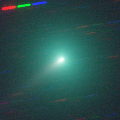
|
It brightened very rapidly. Now it is very bright as 6.9 mag (Apr. 2, Charles S. Morris). It moves along the same orbit as C/1844 Y1 (Great Comet). It approaches to Sun down to 0.25 a.u. on May 31. It is expected to brighten up to -1 mag. In the Northern Hemisphere, it stays observable in excellent condition until mid May when it brightens up to 1-2 mag. In the Southern Hemisphere, it is not observable until June.
Date(TT) R.A. (2000) Decl. Delta r Elong. m1 Best Time(A, h)
Apr. 4 7 33.31 68 17.0 1.035 1.419 88 7.1 19:50 (169, 55)
Apr. 11 6 48.93 67 3.3 1.012 1.287 79 6.6 19:57 (158, 52)
|
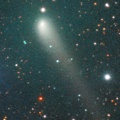
|
Now it is 8.6 mag (Apr. 2, Maik Meyer). It stays bright as 8-9 mag until July. It is observable in good condition in the Northern Hemisphere. In the Southern Hemisphere, it is not observable until July.
Date(TT) R.A. (2000) Decl. Delta r Elong. m1 Best Time(A, h)
Apr. 4 3 11.74 69 41.2 1.764 1.668 67 8.3 19:50 (155, 35)
Apr. 11 3 41.12 71 48.9 1.753 1.647 67 8.3 19:57 (158, 35)
|
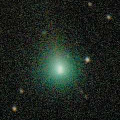
|
Now it is very bright as 8.3 mag (Apr. 2, Maik Meyer). It stays bright as 8-9 mag until mid April. It stays observable for a long time in the Northern Hemisphere. In the Southern Hemisphere, it is not observable until June when it fades down to 15 mag. It seems to be a fragment of C/1988 A1 (Liller), like C/1996 Q1 (Tabur) and C/2015 F3 (SWAN).
Date(TT) R.A. (2000) Decl. Delta r Elong. m1 Best Time(A, h)
Apr. 4 0 22.08 50 5.8 1.287 0.913 44 8.6 4:16 (219, 16)
Apr. 11 0 34.76 58 13.2 1.220 0.970 50 9.1 4:05 (213, 21)
|

|
Recovered from SWAN images after 24-year blank. Now it is very bright as 10.7 mag (Apr. 7, Michael Mattiazzo). It stays 10-11 mag until August. In the Southern Hemisphere, it stays observable in the morning sky for a long time. In the Northern Hemisphere, it is too low to observe until July.
Date(TT) R.A. (2000) Decl. Delta r Elong. m1 Best Time(A, h)
Apr. 4 22 47.85 -4 35.0 2.254 1.515 32 11.3 4:16 (276, 1)
Apr. 11 23 10.11 -3 0.5 2.204 1.483 33 11.0 4:05 (274, 1)
|

|
It has not been observed yet in this apparition. The condition of this apparition is bad, and it it not observable before the perihelion passage. It will appear in the evening sky at 12 mag in mid April in the Northern Hemisphere, or at 15 mag in mid May in the Southern Hemisphere. However, it will fade out rapidly, and will be fainter than 18 mag in June.
Date(TT) R.A. (2000) Decl. Delta r Elong. m1 Best Time(A, h)
Apr. 4 2 1.92 10 28.1 1.393 0.535 17 12.0 19:50 (104, -1)
Apr. 11 2 46.28 15 47.1 1.291 0.532 22 11.8 19:57 (107, 4)
|
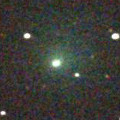
|
Now it is very bright as 11.5 mag (Mar. 30, Marco Goiato). It will approach to Sun down to 0.9 a.u. in June, and it is extected to brighten up to 7.5 mag. In the Southern Hemisphere, it stays observable in good condition for a long time after this. In the Northern Hemisphere, it will be unobservable from late March to late June.
Date(TT) R.A. (2000) Decl. Delta r Elong. m1 Best Time(A, h)
Apr. 4 4 22.09 -23 29.5 1.841 1.574 58 12.2 19:50 ( 57, 5)
Apr. 11 4 32.19 -23 6.8 1.777 1.487 56 11.8 19:57 ( 60, 1)
|

|
Now it is 13.2 mag (Mar. 23, Thomas Lehmann). It stays bright as 12-13 mag until summer. But it becomes low in spring. In the Southern Hemisphere, it will never be observable again.
Date(TT) R.A. (2000) Decl. Delta r Elong. m1 Best Time(A, h)
Apr. 4 0 30.68 54 26.2 3.996 3.424 48 12.8 4:16 (215, 17)
Apr. 11 0 38.81 56 16.1 4.032 3.452 48 12.8 4:05 (214, 19)
|
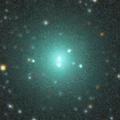
|
It brightened up to 10.2 mag in February (Feb. 6, Maik Meyer). Now it is fading rapidly. It has already faded down to 13.4 mag (Mar. 15, Sandor Szabo). It is observable in good condition in the Northern Hemisphere. In the Southern Hemisphere, it is only visible in the extremely low sky in spring.
Date(TT) R.A. (2000) Decl. Delta r Elong. m1 Best Time(A, h)
Apr. 4 5 33.93 48 25.9 1.726 1.718 72 13.5 19:50 (126, 53)
Apr. 11 5 46.19 44 32.4 1.926 1.804 67 14.0 19:57 (120, 49)
|
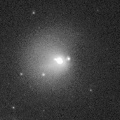
|
Now it is not observable. It will appear in the morning sky in June.
Date(TT) R.A. (2000) Decl. Delta r Elong. m1 Best Time(A, h)
Apr. 4 1 26.15 17 26.0 6.760 5.796 14 13.9 19:50 (115, -5)
Apr. 11 1 31.74 17 57.6 6.781 5.797 10 13.9 19:57 (120, -9)
|
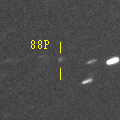
|
Now it is 14.6 mag (Mar. 22, Thomas Lehmann). Brightening very rapidly. It will brighten up to 8-9 mag from summer to autumn. It will be observable in excellent condition in the Southern Hemisphere. It locates very low around the high light in the Northern Hemisphere.
Date(TT) R.A. (2000) Decl. Delta r Elong. m1 Best Time(A, h)
Apr. 4 13 25.88 -3 40.3 1.221 2.216 171 14.2 0:37 ( 0, 51)
Apr. 11 13 18.69 -3 4.9 1.169 2.169 174 13.9 0:02 ( 0, 52)
|
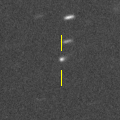
|
Now it is 14.7 mag (Mar. 15, Sandor Szabo). It stays 13-14 mag from 2020 to 2021. It stays observable in good condition for a while.
Date(TT) R.A. (2000) Decl. Delta r Elong. m1 Best Time(A, h)
Apr. 4 12 54.87 17 23.3 2.377 3.321 156 14.3 0:06 ( 0, 72)
Apr. 11 12 49.84 17 36.9 2.379 3.304 153 14.2 23:29 ( 0, 73)
|
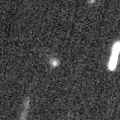
|
Now it is 14.4 mag (Mar. 15, Sandor Szabo). It will brighten up to 10.5 mag from 2020 December to 2021 January. In the Northern Hemisphere, it stays observable in good condition while the comet will be brightening gradually, but it is not observable at the high light. In the Southern Hemisphere, it is not observable for a long time, but it will be observable in good condition after the high light.
Date(TT) R.A. (2000) Decl. Delta r Elong. m1 Best Time(A, h)
Apr. 4 18 21.89 74 53.0 3.299 3.389 86 14.4 4:16 (187, 49)
Apr. 11 18 0.89 76 47.5 3.235 3.324 86 14.3 4:05 (183, 48)
|
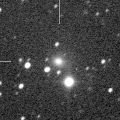
|
Now it is bright as 14.1 mag (Mar. 20, Chris Wyatt). It stays 15 mag until summer. It stays observable for a long time in the Southern Hemisphere. It is not observable until August in the Northern Hemisphere.
Date(TT) R.A. (2000) Decl. Delta r Elong. m1 Best Time(A, h)
Apr. 4 2 8.21 -47 35.4 4.086 3.620 55 14.6 19:50 ( 51,-30)
Apr. 11 2 15.82 -45 45.6 4.112 3.640 55 14.6 19:57 ( 55,-34)
|
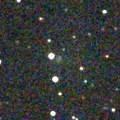
|
Now it is 14.6 mag (Mar. 31, Katsumi Yoshimoto). It will approach to Sun down to 0.29 a.u. on July 3, and it will brighten up to 6 mag. In the Southern Hemisphere, it stays observable in good condition until early June when it brightens up to 11 mag. But it will not be observable around the perihelion passage. In the Northern Hemisphere, it locates in extremely low sky in early April, but it will be unobservable soon. It will appear in the evening sky at 7 mag in mid July, then it stays observable while getting fainter.
Date(TT) R.A. (2000) Decl. Delta r Elong. m1 Best Time(A, h)
Apr. 4 6 43.09 -43 37.5 1.654 1.965 92 15.0 19:50 ( 22, 7)
Apr. 11 6 30.65 -38 20.0 1.631 1.852 85 14.7 19:57 ( 32, 7)
|
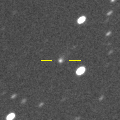
|
Now it is 15.8 mag (Mar. 18, Toshihiko Ikemura, Hirohisa Sato). It will brighten up to 13 mag in 2021. In 2020, it is observable at 15 mag in good condition from spring to summer.
Date(TT) R.A. (2000) Decl. Delta r Elong. m1 Best Time(A, h)
Apr. 4 14 50.09 -18 34.7 4.412 5.293 148 15.5 2:01 ( 0, 36)
Apr. 11 14 45.72 -18 58.7 4.317 5.251 156 15.4 1:29 ( 0, 36)
|

|
Now it is 15.6 mag (Apr. 5, iTelescope Observatory, Siding Spring). It stays 14-15 mag until 2021. In the Southern Hemisphere, it stays observable in good condition for a long time. In the Northern Hemisphere, it is not observable until June in 2021.
Date(TT) R.A. (2000) Decl. Delta r Elong. m1 Best Time(A, h)
Apr. 4 17 12.01 -78 32.8 4.923 5.198 100 15.6 4:16 ( 0,-24)
Apr. 11 17 16.28 -79 37.6 4.842 5.168 103 15.6 4:01 ( 0,-25)
|
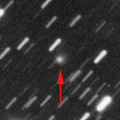
|
Now it is 15.6 mag (Mar. 20, Toshihiko Ikemura, Hirohisa Sato). It is expected to be observable at 5-6 mag for a long time from 2022 to 2023. In the Northern Hemisphere, it is not observable at the high light from 2022 summer to 2023 summer. In the Southern Hemisphere, it is only visible in the extremely low sky in summer in 2020. But it will be observable in good condition at the high light.
Date(TT) R.A. (2000) Decl. Delta r Elong. m1 Best Time(A, h)
Apr. 4 18 18.85 50 4.2 9.388 9.460 91 15.6 4:16 (216, 70)
Apr. 11 18 17.96 50 37.1 9.304 9.410 93 15.6 4:05 (208, 71)
|
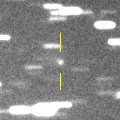
|
First return of a new periodic comet discovered in 2006. It brightened up to 14.9 mag in January (Jan. 21, R. Fichtl). It will never be observable after this.
Date(TT) R.A. (2000) Decl. Delta r Elong. m1 Best Time(A, h)
Apr. 4 1 45.67 0 1.9 2.657 1.706 14 15.6 19:50 ( 98,-11)
Apr. 11 2 5.24 1 28.3 2.673 1.714 13 15.6 19:57 (102,-13)
|
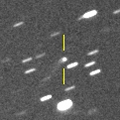
|
Now it is 16.0 mag (Dec. 4, Kunihiro Shima). It stays 15-16 mag for a long time until 2021.
Date(TT) R.A. (2000) Decl. Delta r Elong. m1 Best Time(A, h)
Apr. 4 20 54.22 -2 13.4 4.929 4.515 60 16.0 4:16 (292, 25)
Apr. 11 20 54.82 -0 52.8 4.815 4.508 66 16.0 4:05 (294, 29)
|

|
Now it is 14.6 mag (Dec. 28, Chris Wyatt). It will be fading slowly after this. In the Southern Hemisphere, it becomes low from February to March, but it stays observable for a long time. In the Northern Hemisphere, it is not observasble until June.
Date(TT) R.A. (2000) Decl. Delta r Elong. m1 Best Time(A, h)
Apr. 4 23 45.20 -35 54.9 4.433 3.786 44 16.1 4:16 (297,-27)
Apr. 11 23 50.14 -34 54.7 4.418 3.821 48 16.2 4:05 (297,-24)
|

|
It brightened up to 7.7 mag in June in 2018 (June 19, Juan Jose Gonzalez). Now it is fading. It has already faded down to 16.4 mag (Mar. 20, Toshihiko Ikemura, Hirohisa Sato). In the Southern Hemisphere, it stays observable for a long time until the comet will fade out. In the Northern Hemisphere, it stays low for a while.
Date(TT) R.A. (2000) Decl. Delta r Elong. m1 Best Time(A, h)
Apr. 4 5 33.94 -17 22.2 6.584 6.364 73 16.3 19:50 ( 49, 21)
Apr. 11 5 35.95 -16 25.0 6.722 6.419 68 16.4 19:57 ( 55, 17)
|
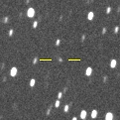
|
Now it is 17.2 mag (Mar. 20, Toshihiko Ikemura, Hirohisa Sato). It will stay at 14 mag for a long time from 2021 to 2022. In the Northern Hemisphere, it stays observable in good condition while brightening gradually. In the Southern Hemisphere, it is appearing in the morning sky. But it stays locating low for a long time.
Date(TT) R.A. (2000) Decl. Delta r Elong. m1 Best Time(A, h)
Apr. 4 19 15.47 31 57.6 6.669 6.609 82 16.4 4:16 (267, 63)
Apr. 11 19 14.47 32 23.2 6.562 6.576 86 16.4 4:05 (268, 67)
|
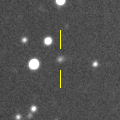
|
Now it is 16.1 mag (Mar. 18, Toshihiko Ikemura, Hirohisa Sato). It stays observable at 16-17 mag from 2020 to 2021. It locates somewhat low in the Northern Hemisphere.
Date(TT) R.A. (2000) Decl. Delta r Elong. m1 Best Time(A, h)
Apr. 4 10 42.36 -21 47.5 5.744 6.585 144 16.5 21:50 ( 0, 33)
Apr. 11 10 41.43 -21 6.5 5.784 6.583 140 16.5 21:21 ( 0, 34)
|
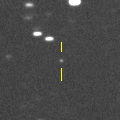
|
Now it is 16.1 mag (Mar. 18, Toshihiko Ikemura, Hirohisa Sato). It stays observable at 16 mag in good condition until April.
Date(TT) R.A. (2000) Decl. Delta r Elong. m1 Best Time(A, h)
Apr. 4 10 4.75 22 2.5 0.829 1.662 130 16.5 21:12 ( 0, 77)
Apr. 11 10 0.58 17 43.2 0.865 1.654 124 16.6 20:40 ( 0, 72)
|
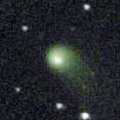
|
It brightened up to 12-13 mag from 2018 to 2019. Now it is fading. It has already faded down to 16.5 mag (Mar. 8, J. Drummond). In the Southern Hemisphere, it stays observable in good condition for a long time. It will never be observable after this in the Northern Hemisphere.
Date(TT) R.A. (2000) Decl. Delta r Elong. m1 Best Time(A, h)
Apr. 4 10 32.97 -75 11.0 4.773 5.166 107 16.5 21:38 ( 0,-20)
Apr. 11 10 8.90 -73 58.8 4.800 5.211 108 16.6 20:47 ( 0,-19)
|
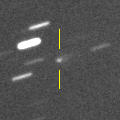
|
Now it is 16.4 mag (Mar. 19, Thomas Lehmann). It brightens up to 16.5 mag and will be observable in good condition from March to April.
Date(TT) R.A. (2000) Decl. Delta r Elong. m1 Best Time(A, h)
Apr. 4 13 20.19 0 20.0 1.180 2.174 170 16.5 0:31 ( 0, 55)
Apr. 11 13 15.33 0 36.9 1.190 2.185 171 16.6 23:54 ( 0, 56)
|
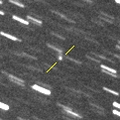
|
Now it is 16.4 mag (Feb. 28, iTelescope Observatory, Siding Spring). It started getting fainter before the perihelion passage. It seems to be fainter than 18 mag in June. In the Southern Hemisphere, it will be too low to observe soon. It is not observable in the Northern Hemisphere.
Date(TT) R.A. (2000) Decl. Delta r Elong. m1 Best Time(A, h)
Apr. 4 3 27.68 -35 15.8 2.517 2.105 54 16.5 19:50 ( 55,-11)
Apr. 11 3 40.70 -31 18.7 2.593 2.131 52 16.7 19:57 ( 61,-13)
|

|
Now it is 15.8 mag (Mar. 1, iTelescope Observatory, Siding Spring). It is observable at 16.5 mag in 2020. It is observable in excellent condition in the Southern Hemisphere. It locates somewhat low in the Northern Hemisphere.
Date(TT) R.A. (2000) Decl. Delta r Elong. m1 Best Time(A, h)
Apr. 4 20 10.20 -30 2.9 6.730 6.567 76 16.7 4:16 (320, 12)
Apr. 11 20 8.82 -29 57.6 6.616 6.577 83 16.6 4:05 (324, 14)
|
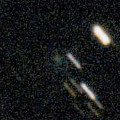
|
Now it is 16.9 mag (Mar. 18, Toshihiko Ikemura, Hirohisa Sato). It stays 16.5 mag until late March. It is not observable in the Southern Hemisphere.
Date(TT) R.A. (2000) Decl. Delta r Elong. m1 Best Time(A, h)
Apr. 4 3 34.52 35 16.4 2.062 1.569 47 16.8 19:50 (115, 29)
Apr. 11 3 59.38 36 58.1 2.118 1.599 46 17.0 19:57 (117, 28)
|
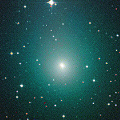
|
It brightened up to 8.3 mag in September (Sept. 20, Maik Meyer). Now it is fading. It has already faded down to 14.9 mag (Dec. 28, Chris Wyatt). In the Southern Hemisphere, it stays observable for a long time after this. In the Northern Hemisphere, it will never be observable again.
Date(TT) R.A. (2000) Decl. Delta r Elong. m1 Best Time(A, h)
Apr. 4 0 10.93 -54 44.1 3.459 3.101 61 16.8 4:16 (316,-37)
Apr. 11 0 23.15 -56 2.4 3.456 3.172 65 17.0 4:05 (318,-36)
|
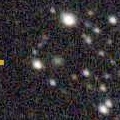
|
Now it is 17.4 mag (Jan. 24, Thomas Lehmann). It will brighten up to 12 mag in winter in 2022. In the Northern Hemisphere, it stays observable in good condition for a long time. In the Southern Hemisphere, it is not observable until 2021 November.
Date(TT) R.A. (2000) Decl. Delta r Elong. m1 Best Time(A, h)
Apr. 4 23 32.26 44 9.3 7.243 6.539 42 17.0 4:16 (229, 19)
Apr. 11 23 38.66 44 52.0 7.197 6.494 42 16.9 4:05 (229, 21)
|
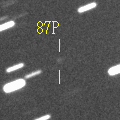
|
Now it is 16.3 mag (Mar. 20, Toshihiko Ikemura, Hirohisa Sato). It will brighten up to 17 mag and will be observable in excellent condition from March to May.
Date(TT) R.A. (2000) Decl. Delta r Elong. m1 Best Time(A, h)
Apr. 4 12 47.44 -4 1.3 1.116 2.116 177 17.0 23:54 ( 0, 51)
Apr. 11 12 43.44 -3 21.8 1.116 2.110 169 17.0 23:23 ( 0, 52)
|

|
Now it is 18.3 mag (Mar. 18, Catalina Sky Survey). It will brighten rapidly, and will brighten up to 9.5 mag in June. It is not observable in June. However, it stays observable in good condition until May while the comet is brightening, and after July while the comet will be fading.
Date(TT) R.A. (2000) Decl. Delta r Elong. m1 Best Time(A, h)
Apr. 4 10 40.50 -10 8.9 0.652 1.587 146 17.1 21:46 ( 0, 45)
Apr. 11 10 19.22 -7 34.4 0.607 1.497 135 17.0 20:58 ( 0, 48)
|
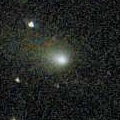
|
It brightened up to 13.8 mag in 2019 winter (Dec. 21, Thomas Lehmann). Now it is fading. It has already faded down to 17.2 mag (Mar. 18, Toshihiko Ikemura, Hirohisa Sato). It will be fainter than 18 mag in May. In the Northern Hemisphere, it is observable in excellent condition. It locates low in the Southern Hemisphere.
Date(TT) R.A. (2000) Decl. Delta r Elong. m1 Best Time(A, h)
Apr. 4 6 16.76 11 6.4 1.649 1.775 80 17.1 19:50 ( 63, 49)
Apr. 11 6 33.38 10 29.1 1.736 1.806 77 17.3 19:57 ( 66, 46)
|

|
It will brighten up to 15.5 mag and will be observable in good condition from June to September.
Date(TT) R.A. (2000) Decl. Delta r Elong. m1 Best Time(A, h)
Apr. 4 19 31.76 -3 14.6 2.408 2.454 80 17.2 4:16 (311, 39)
Apr. 11 19 41.32 -1 50.9 2.309 2.430 84 17.1 4:05 (311, 41)
|
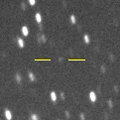
|
Now it is 17.4 mag (Feb. 23, Toshihiko Ikemura, Hirohisa Sato). It is expected to brighten up to 13 mag in 2022. In 2020, it is observable in excellent condition in the Southern Hemisphere. In the Northern Hemisphere, it will be unobservable soon. It will be observable again from autumn to winter, but it locating extremely low.
Date(TT) R.A. (2000) Decl. Delta r Elong. m1 Best Time(A, h)
Apr. 4 6 12.70 -29 49.9 7.558 7.522 84 17.2 19:50 ( 33, 16)
Apr. 11 6 15.07 -29 12.5 7.583 7.482 80 17.1 19:57 ( 40, 13)
|
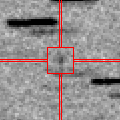
|
Now it is 17.6 mag (Mar. 22, Toshihiko Ikemura, Hirohisa Sato). It will brighten up to 15.5 mag from June to August, and it will be observable in good condition.
Date(TT) R.A. (2000) Decl. Delta r Elong. m1 Best Time(A, h)
Apr. 4 18 33.07 -9 54.8 1.953 2.283 95 17.3 4:16 (331, 41)
Apr. 11 18 42.58 -9 4.0 1.855 2.259 100 17.2 4:05 (333, 42)
|

|
Now it is 17.6 mag (Feb. 3, ATLAS-HKO, Haleakala). It brightened up to 14 mag from autumn to winter in 2018. Now it is fading. It is observable at 17.5 mag in good condition from winter to spring.
Date(TT) R.A. (2000) Decl. Delta r Elong. m1 Best Time(A, h)
Apr. 4 13 14.82 -3 6.0 3.703 4.699 173 17.2 0:26 ( 0, 52)
Apr. 11 13 9.16 -3 2.6 3.739 4.738 174 17.2 23:48 ( 0, 52)
|

|
Now it is 18.3 mag (Mar. 22, Toshihiko Ikemura, Hirohisa Sato). It will be fading slowly after this. It is observable in good condition in the Northern Hemisphere. In the Southern Hemisphere, it is observable in the extremely low sky only in 2021 spring.
Date(TT) R.A. (2000) Decl. Delta r Elong. m1 Best Time(A, h)
Apr. 4 13 3.24 56 0.5 8.254 8.772 118 17.3 0:14 (180, 69)
Apr. 11 12 58.99 55 47.7 8.301 8.783 115 17.3 23:38 (180, 69)
|
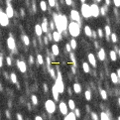
|
Now it is 17.5 mag (Mar. 20, Toshihiko Ikemura, Hirohisa Sato). It will be observable at 16.5-17 mag from spring in 2020 to summer in 2021.
Date(TT) R.A. (2000) Decl. Delta r Elong. m1 Best Time(A, h)
Apr. 4 20 2.30 21 32.0 5.156 4.936 71 17.4 4:16 (277, 49)
Apr. 11 20 0.80 21 57.5 5.042 4.918 77 17.3 4:05 (280, 53)
|

|
Now it is 17.3 mag (Mar. 24, Toshihiko Ikemura, Hirohisa Sato). It stays observable at 16-17 mag for a long time until 2024.
Date(TT) R.A. (2000) Decl. Delta r Elong. m1 Best Time(A, h)
Apr. 4 16 24.19 -19 15.9 9.397 10.029 126 17.4 3:35 ( 0, 36)
Apr. 11 16 21.10 -19 1.8 9.282 10.011 134 17.3 3:04 ( 0, 36)
|
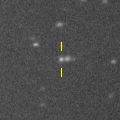
|
Now it is 17.4 mag (Mar. 18, Toshihiko Ikemura, Hirohisa Sato). It will brighten up to 13 mag in 2022. In 2020, it is observable at 17.5 mag in good condition in spring. It locates somewhat low in the Southern Hemisphere.
Date(TT) R.A. (2000) Decl. Delta r Elong. m1 Best Time(A, h)
Apr. 4 10 12.43 22 8.3 3.747 4.476 131 17.6 21:20 ( 0, 77)
Apr. 11 10 10.38 22 4.2 3.815 4.463 124 17.6 20:50 ( 0, 77)
|

|
It brightened up to 13 mag from autumn to winter in 2018. Now it is fading. It has already faded down to 17.0 mag (Mar. 17, Toshihiko Ikemura, Hirohisa Sato). It will be fainter than 18 mag in April.
Date(TT) R.A. (2000) Decl. Delta r Elong. m1 Best Time(A, h)
Apr. 4 8 49.06 10 46.0 2.736 3.313 117 17.8 19:57 ( 0, 66)
Apr. 11 8 50.79 10 56.9 2.857 3.345 110 18.0 19:57 ( 15, 65)
|
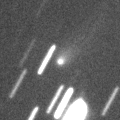
|
It brightened up to 14.5 mag in December (Dec. 22, Alan Hale). Now it is 17.4 mag (Mar. 13, E. Jehin, et al.). The orbit is extremely hyperbolic with e=3.35. It is the first interstellar comet in history. It will be fading after this, and will be fainter than 18 mag in April. In the Southern Hemisphere, it is observable in excellent condition. In the Northern Hemisphere, it will never be observable again.
Date(TT) R.A. (2000) Decl. Delta r Elong. m1 Best Time(A, h)
Apr. 4 12 40.61 -70 5.7 2.705 3.264 115 17.8 23:47 ( 0,-15)
Apr. 11 12 36.13 -70 2.5 2.797 3.383 117 18.0 23:15 ( 0,-15)
|
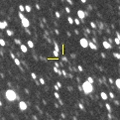
|
Now it is 17.8 mag (Oct. 9, Toshihiko Ikemura, Hirohisa Sato). It stays observable at 18 mag for a long time from 2019 to 2021.
Date(TT) R.A. (2000) Decl. Delta r Elong. m1 Best Time(A, h)
Apr. 4 19 17.57 -14 48.0 7.691 7.679 85 17.9 4:16 (322, 31)
Apr. 11 19 18.12 -15 7.9 7.574 7.679 92 17.8 4:05 (326, 33)
|

|
It will pass the perihelion in 2021, and it is predicted to be observable at 17-18 mag from 2020 to 2022. However, it has not been observed at all since 2015. It was not detected, fainter than 20.5 mag, in 2017 May (Werner Hasubick).
Date(TT) R.A. (2000) Decl. Delta r Elong. m1 Best Time(A, h)
Apr. 4 20 24.99 -22 46.9 6.391 6.144 71 17.9 4:16 (313, 15)
Apr. 11 20 28.65 -22 34.8 6.271 6.130 77 17.9 4:05 (315, 17)
|

|
It brightened up to 15.5 mag from 2017 to 2018. Now it is fading. It has already faded down to 17.7 mag (Mar. 20, Toshihiko Ikemura, Hirohisa Sato). It will be fainter than 18 mag in late April.
Date(TT) R.A. (2000) Decl. Delta r Elong. m1 Best Time(A, h)
Apr. 4 12 36.01 10 42.1 9.897 10.858 163 17.9 23:43 ( 0, 66)
Apr. 11 12 34.58 10 57.0 9.941 10.876 157 17.9 23:14 ( 0, 66)
|
|
![]()
 210P/Christensen
210P/Christensen C/2019 U6 ( Lemmon )
C/2019 U6 ( Lemmon ) C/2018 N2 ( ASASSN )
C/2018 N2 ( ASASSN ) C/2020 A2 ( Iwamoto )
C/2020 A2 ( Iwamoto ) 29P/Schwassmann-Wachmann 1
29P/Schwassmann-Wachmann 1 88P/Howell
88P/Howell 246P/NEAT
246P/NEAT C/2019 N1 ( ATLAS )
C/2019 N1 ( ATLAS ) C/2018 F4 ( PanSTARRS )
C/2018 F4 ( PanSTARRS ) C/2020 F3 ( NEOWISE )
C/2020 F3 ( NEOWISE ) C/2019 F1 ( ATLAS-Africano )
C/2019 F1 ( ATLAS-Africano ) C/2020 F5 ( MASTER )
C/2020 F5 ( MASTER ) C/2017 K2 ( PanSTARRS )
C/2017 K2 ( PanSTARRS ) 390P/2019 U1 ( Gibbs )
390P/2019 U1 ( Gibbs ) C/2019 K7 ( Smith )
C/2019 K7 ( Smith ) C/2018 A6 ( Gibbs )
C/2018 A6 ( Gibbs ) C/2016 M1 ( PanSTARRS )
C/2016 M1 ( PanSTARRS ) C/2018 U1 ( Lemmon )
C/2018 U1 ( Lemmon ) C/2019 C1 ( ATLAS )
C/2019 C1 ( ATLAS ) 124P/Mrkos
124P/Mrkos C/2017 M4 ( ATLAS )
C/2017 M4 ( ATLAS ) P/2019 Y2 ( Fuls )
P/2019 Y2 ( Fuls ) C/2019 K1 ( ATLAS )
C/2019 K1 ( ATLAS ) C/2017 U7 ( PanSTARRS )
C/2017 U7 ( PanSTARRS ) 112P/Urata-Niijima
112P/Urata-Niijima C/2018 W2 ( Africano )
C/2018 W2 ( Africano ) C/2019 L3 ( ATLAS )
C/2019 L3 ( ATLAS ) 87P/Bus
87P/Bus 249P/LINEAR
249P/LINEAR 114P/Wiseman-Skiff
114P/Wiseman-Skiff 257P/Catalina
257P/Catalina C/2019 T4 ( ATLAS )
C/2019 T4 ( ATLAS ) 115P/Maury
115P/Maury (944) Hidalgo
(944) Hidalgo C/2010 U3 ( Boattini )
C/2010 U3 ( Boattini ) C/2017 Y2 ( PanSTARRS )
C/2017 Y2 ( PanSTARRS ) C/2020 F2 ( ATLAS )
C/2020 F2 ( ATLAS ) 117P/Helin-Roman-Alu 1
117P/Helin-Roman-Alu 1 78P/Gehrels 2
78P/Gehrels 2 2I/2019 Q4 ( Borisov )
2I/2019 Q4 ( Borisov ) C/2017 K5 ( PanSTARRS )
C/2017 K5 ( PanSTARRS ) C/2014 F3 ( Sheppard-Trujillo )
C/2014 F3 ( Sheppard-Trujillo ) C/2014 B1 ( Schwartz )
C/2014 B1 ( Schwartz )![]()







































